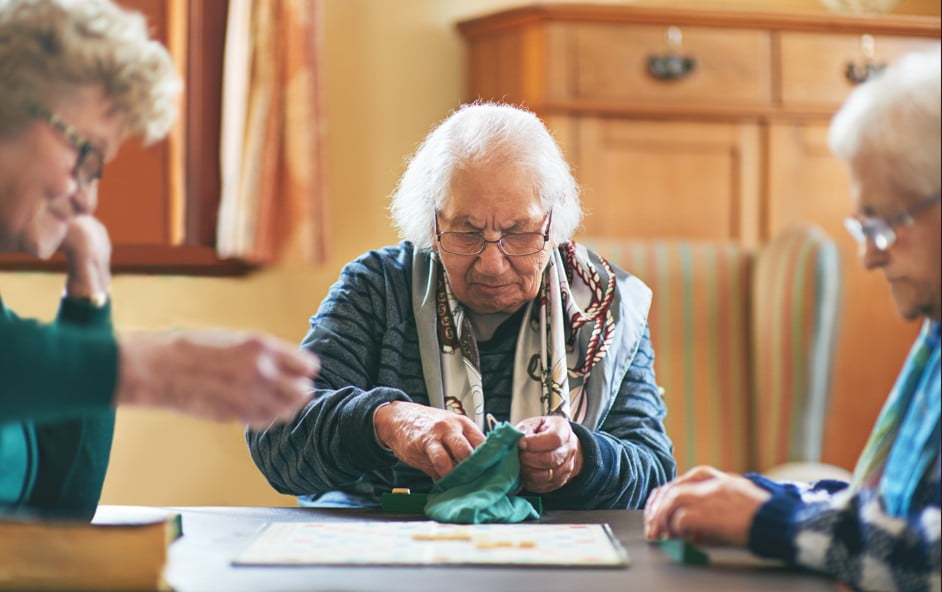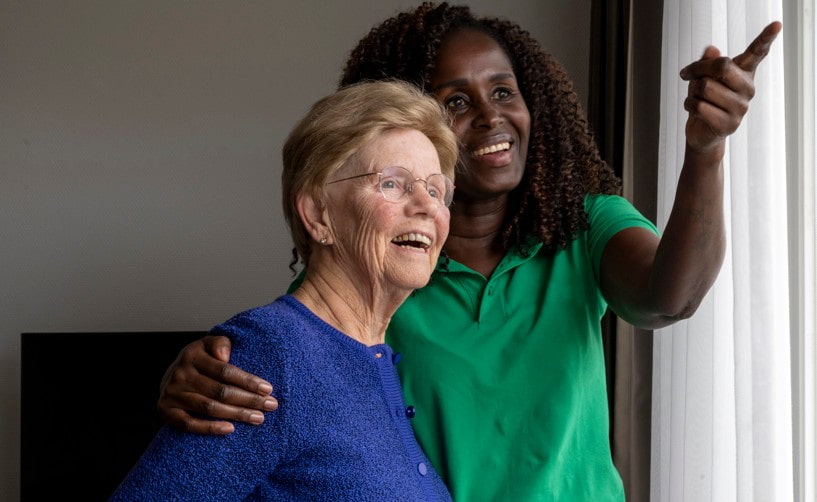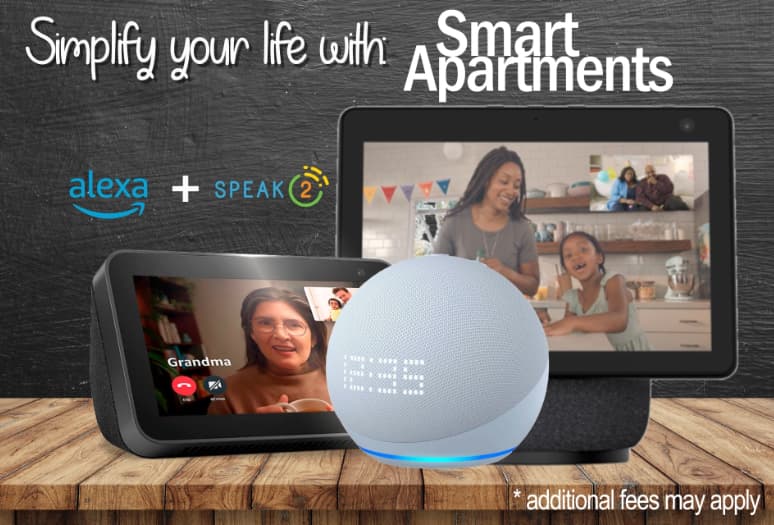Understanding Memory Care in Georgia
What makes Memory Care different from Assisted Living?
Picture this:
You visit two communities. In one, the halls look like regular apartment buildings. In the other, the hallways loop back into familiar spaces. There are quiet corners with soft lighting, safe outdoor patios, and colors chosen to calm the mind. That second place is Memory Care.
The difference isn’t just in the walls; it’s in the daily rhythm.
- Assisted Living = support with meals, medications, dressing.
- Memory Care = all of the above plus environments and staff prepared for memory loss.
Here’s what families often notice right away in Memory Care:
- Staff who answer the same question with patience, again and again.
- Activities designed to spark memories, music circles, sensory art, storytelling.
- A routine that reduces anxiety, helping residents feel safe in a world that can often feel confusing.
So when you ask “what’s the difference?” the answer is: safety + purpose + trained compassion.
How do I know if it’s the right time for Memory Care?
Ask yourself:
Has my loved one gotten lost in familiar places?
Do I worry every night about wandering or accidents?
Am I so exhausted that my own health is starting to suffer?
If two or more answers are “yes,” that’s usually the sign families in Georgia talk about when they say “we knew it was time.”
Some common triggers families share:
- The stove incident. Forgetting to turn it off.
- The night walk. Waking up and finding the front door unlocked.
- The caregiver’s breaking point. When worry and fatigue take over daily life.
What happens after moving into Memory Care?
- Predictable routines calm the day.
- Meals and medications are managed.
- Activities bring moments of connection, even when words are slipping away.
- Families get to step back into their role as sons, daughters, or spouses, instead of being full-time nurses.
It’s not an easy step, but most families describe the same outcome: a safer life for their loved one, and a lighter heart for themselves.
Costs, Coverage, and Financial Options
What is the average cost of Memory Care in Georgia?
When you tour a community, ask directly: What is the monthly cost and what does it include?
In Georgia, Memory Care often falls between $4,500 and $6,000 per month. The key is not just the number, but the breakdown.
Ask:
Does the fee cover 24-hour staff presence?
Are medication services included, or billed separately?
How are meals and activities factored in?
Are there additional charges for higher levels of care?
Look for communities that are transparent and willing to show you how their fees compare to the hidden costs of keeping care at home—home modifications, private caregivers, or missed workdays.
Do health plans or private coverage help with expenses?
Families often ask: Will my current coverage reduce the cost?
Most health insurance covers short-term medical treatments, but not long-term residential Memory Care. Long-term care policies may help, but it’s important to ask about waiting periods and exactly what is covered.
Questions to bring on your visit:
Do you work with families who have long-term care policies?
Can you guide me in understanding what parts of the cost may be deductible as medical expenses?
What financing options are available if I need support while waiting for funds from a home sale or policy payout?
This is where communities with strong financial guidance stand out, they anticipate these questions and walk families through realistic options.

Are there local resources or financial assistance for families?
Don’t leave without asking: What local programs or partners can help families like mine afford this care?
In Georgia, many families explore veteran support programs, bridge loans, or home equity solutions. Others look into shared housing models that lower costs while still offering full services.
At Legacy Ridge at Buckhead, families are connected with trusted financial partners who specialize in senior living planning. These advisors can help combine resources—savings, insurance, benefits—into one clear plan.
The best insight you can take from this part of the visit is whether the community offers only a monthly fee, or whether they also provide guidance, tools, and flexibility to make the move possible.
Quality of Care and Staff Training
How are caregivers trained to work with dementia and Alzheimer’s residents?
Training goes far beyond helping with meals or medications. Caregivers in Memory Care learn how dementia feels from the inside. Many programs even simulate the experience, glasses that blur vision, gloves that reduce dexterity, headphones that play overlapping sounds to help staff understand the confusion and anxiety a resident might feel.
They also practice specific approaches:
- Responding calmly to repeated questions without showing frustration
- Redirecting agitation into safe, soothing activities like folding linens or listening to familiar music
- Using short, clear sentences and positive body language
- Creating routines that bring comfort and predictability
Families often notice the difference right away. Instead of simply “managing behaviors,” trained caregivers build trust and restore dignity in daily moments.
What is the staff-to-resident ratio, day and night?
This is one of the first questions families ask during a tour, and with good reason. Dementia doesn’t follow a schedule. Someone may be calm in the afternoon and restless at 2 a.m. That’s why ratios matter.
During the day, there are usually more caregivers available to guide group activities, meals, and personal care. At night, staffing remains steady enough to ensure safety, respond to wandering, and offer comfort when residents wake up disoriented. A strong ratio means no one is left waiting for help and caregivers have the time to respond with patience rather than rushing.
For families, this translates to peace of mind: knowing that someone is always nearby, not just “on call.”
How does the community handle medical emergencies?
Families want to know: What happens if Mom falls? What if Dad has a sudden change in health?
In Memory Care communities, the response is structured and practiced:
- Associates are trained in first response and CPR
- Nurses (RN or LPN, depending on the community) are part of the leadership team
- Emergency protocols are rehearsed regularly so that staff know exactly who to call, what steps to take, and how to keep families informed
- Local hospitals and urgent care centers often have established relationships with communities, ensuring a smoother transition if transport is needed
The goal isn’t just reacting quickly, but reacting with clarity. Families are contacted immediately, medical teams are prepared, and the resident is supported with calm reassurance throughout the process.
Daily Life, Activities, and Engagement
What types of activities help residents stay active and connected?
When you visit, don’t just ask “what activities do you offer.” Watch what’s on the calendar, and more importantly, notice how residents participate. Memory Care activities aren’t about filling time, they’re about sparking recognition, lowering stress, and creating joy.
Good signs to look for:
- Music circles where familiar songs bring back smiles and foot-tapping.
- Art or sensory projects designed to engage touch and creativity, not just fine motor skills.
- Small-group games that encourage connection without overwhelming.
- Physical activities like gentle chair yoga or short walks in safe courtyards.
Ask the team: How do you adapt activities when a resident is having a harder day? The best communities don’t push—they meet each resident where they are, every single day.
How are meals planned and tailored to memory care residents?
Dining is often overlooked, but it tells you so much about daily care. During your visit, notice if the dining space feels calm and inviting. Residents with dementia may struggle with utensils, colors on a plate, or distractions around them.
Questions to ask:
Do you adjust portion sizes and textures for residents who have trouble chewing or swallowing?
Are meals served at consistent times to create routine?
Do staff gently guide residents who forget to eat, rather than rushing them?
Communities that take nutrition seriously often use colorful plates to increase appetite, offer finger foods for independence, and encourage hydration through creative options like fruit-infused water. These details prevent weight loss, improve energy, and keep residents engaged in social dining.
What role does family involvement play in daily routines?
One of the most important insights during a tour is how families are welcomed into daily life. Some communities treat family visits as occasional extras. Others weave them into the rhythm of the week.
Look for answers to these questions:
Can families join meals or activities without advance notice?
Do you host support groups or family education sessions?
How do you communicate daily updates—phone calls, newsletters, or family portals?
The strongest communities see families as partners, not visitors. They understand that your presence can calm a resident, spark conversation, or keep traditions alive. When you ask this question, pay attention to the tone of the answer. A team that lights up when talking about family involvement usually means they value those connections deeply.

Safety, Security, and Environment
What safety measures are in place to prevent wandering or accidents?
This is one of the first questions to ask during your visit: How do you keep residents safe, especially if they wander or become disoriented?
Look for answers that mention:
- Secured entry and exit points that prevent unsupervised leaving
- Motion sensors or discreet alarms that alert staff when residents move at night
- 24-hour staff presence to respond quickly to falls or emergencies
- Clear signage and visual cues to help residents navigate hallways without confusion
When touring, notice whether staff can describe specific protocols—for example, how they respond if someone leaves their room at 2 a.m. The strongest communities will be open about their safety routines.
How secure is the community while still feeling welcoming and home-like?
Families often worry that security could feel restrictive. The best communities balance protection with warmth. Ask: How do you create safety without making it feel like a locked facility?
During your tour, pay attention to:
- Doors and hallways that are secure but not intimidating
- Natural light and calming design elements that reduce anxiety
- Private spaces where residents can retreat without feeling isolated
- Staff interactions that show respect rather than control
A good sign: residents moving freely in common areas, engaged and comfortable, while staff remain nearby and attentive.
Are there outdoor spaces that are safe for residents to enjoy?
Ask directly: Can my loved one safely go outside every day? Fresh air and sunshine are essential for well-being, especially for seniors with dementia.
Look for:
- Enclosed courtyards or gardens with walking paths
- Shaded seating areas that encourage socializing or quiet time
- Safe fencing that blends naturally with the landscape
- Staff supervision during outdoor activities
When touring, step outside yourself. Notice whether the space feels like an inviting garden, not just a secured yard. Outdoor areas should be both safe and uplifting, offering residents a chance to connect with nature without risk.
Planning for the Future
How does the community support families as dementia progresses?
Ask: What happens as my loved one’s needs change? Dementia is progressive, and care that works today may not be enough tomorrow. The right community should explain how they adapt care plans over time.
Look for:
- Regular care plan meetings with nurses and family
- Flexibility to add more support as mobility or medical needs shift
- Programs that continue to engage residents even in later stages of dementia
A strong answer will reassure you that your loved one will not outgrow the community’s ability to care for them.
What end-of-life care options are available?
It’s difficult to ask, but important: How do you handle the most advanced stages of dementia and end-of-life care?
Questions to guide the conversation:
Do you collaborate with hospice providers?
How do you keep families involved in decision-making during this stage?
What emotional and spiritual support is offered to both residents and families?
The best communities approach this topic with compassion, openness, and a willingness to talk about the realities of advanced care.
Why ask these questions now?
Families often wait until a crisis forces decisions. By asking now, you gain clarity and avoid surprises later. It’s not about predicting every turn of the journey—it’s about knowing that the community will walk alongside you through each stage.






